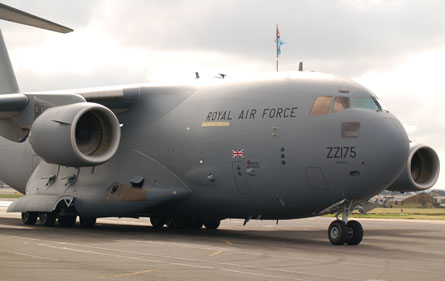With the UK's airborne supply activities inside Afghanistan and Iraq being largely provided by Lockheed Martin C-130J/K transports and Boeing CH-47 Chinook helicopters, the Royal Air Force's ability to maintain an air bridge with both theatres is a critical factor in enabling operations.
In its first fleet expansion since 2001, the RAF's 99 Sqn in early April received its fifth Boeing C-17 strategic transport, joining four aircraft leased from Boeing in 2000 under the UK Ministry of Defence's short-term strategic airlift project.
 |
|---|
© Craig Hoyle/Flight International |
These were originally intended to fill a capability gap caused by the delayed launch of Europe's Airbus Military A400M project, but world events post-9/11 have led to them typically being flown at 130% of their planned utilisation rates, amassing a combined 41,000h since 2001. The aircraft routinely serve both operational theatres several times a week, with three transports often away simultaneously and a turnaround time of 6h not unusual.
Although the C-17 can carry a 75t payload, the RAF says its aircraft typically transport around 45t of supplies to theatre. The fleet also moved almost 57,000 passengers in the five years up to March. "These aircraft have delivered, and are totally fit for purpose as strategic freighters," says Air Vice Marshal Andrew Pulford, air officer commanding the RAF's 2 Grp.
A key contributor to the UK's success has been its membership of the US Air Force's C-17 Globemaster Sustainment Program, under which it contracts Boeing to provide performance-based logistics support services for the fleet at RAF Brize Norton, Oxfordshire.
Fourteen Boeing personnel and a Pratt & Whitney representative are assigned to a field service team at the base. Their services include making judgements on the need for minor repairs, which saves having to wait several hours to contact engineers in the USA. "That's one way that we can keep aircraft availability so high we don't have that time lag," says Trevor Kirby, the company's on-site manager at Brize Norton.
UK C-17s receive day-to-day flightline maintenance from an engineering team of 140 RAF personnel, while a home station check is conducted every 120 days. Lasting roughly 10 days, this process includes work such as integrating minor system upgrades, plus performing engine filter checks, lubrication and airframe washing.
Along with fellow C-17 operators Australia and Canada, the UK also buys access to global fleet data on issues such as structural and reliability factors, and can leverage off investment in block upgrades to the USAF's eventual fleet of at least 190 of the aircraft under its Global Reach Improvement Program. The UK's first four C-17s are to be upgraded to the Block 16 standard at Boeing's San Antonio plant in Texas before this decade is over, receiving equipment including a new weather radar.
"Without the global support arrangement, things would have been much more difficult," says James Evans, C-17 integrated project team leader for the UK's Defence Equipment & Support organisation. The UK's lease, purchase and support costs for the type have been projected at around £2 billion ($3.96 billion), with this including a sixth aircraft to be accepted in early June and the completion of a purchase of the original leased fleet by September. Meanwhile, the RAF hopes to acquire a further two aircraft "as soon as possible", says Pulford.
Hailing the success of the UK's use of the airlifter, Boeing international C-17 programme manager Tommy Dunehew says: "This is our model programme when we go elsewhere."
Source: Flight International
















